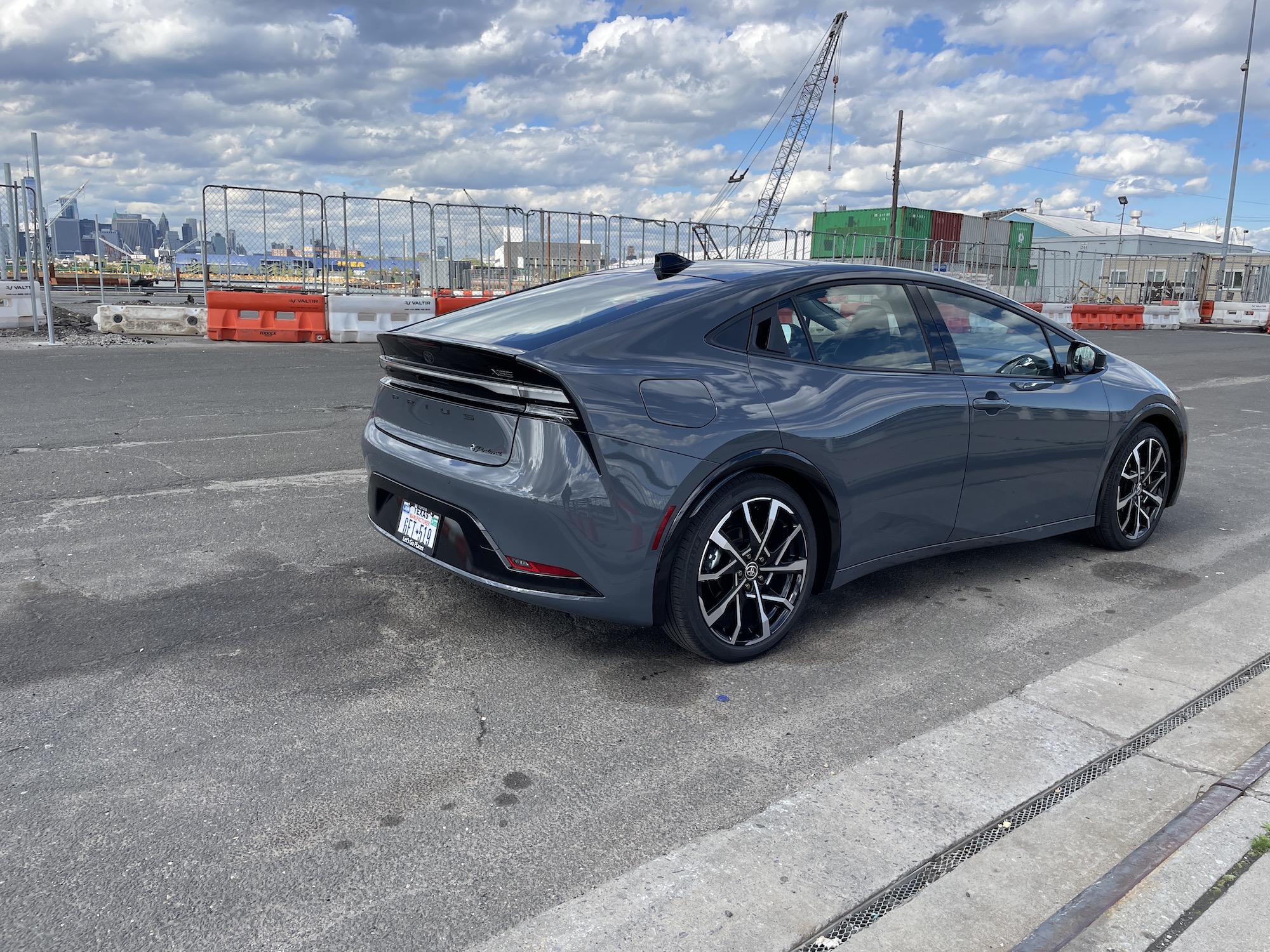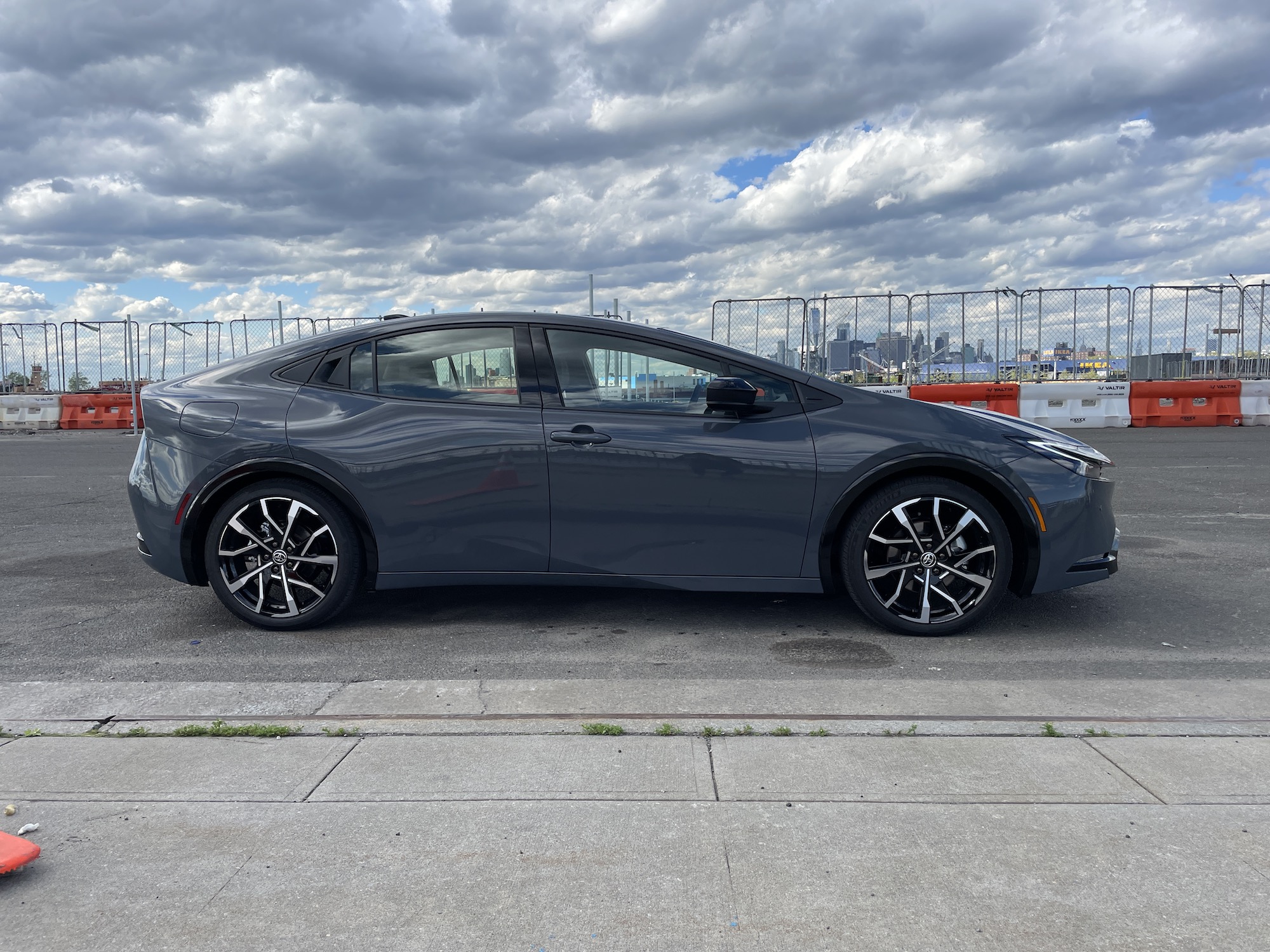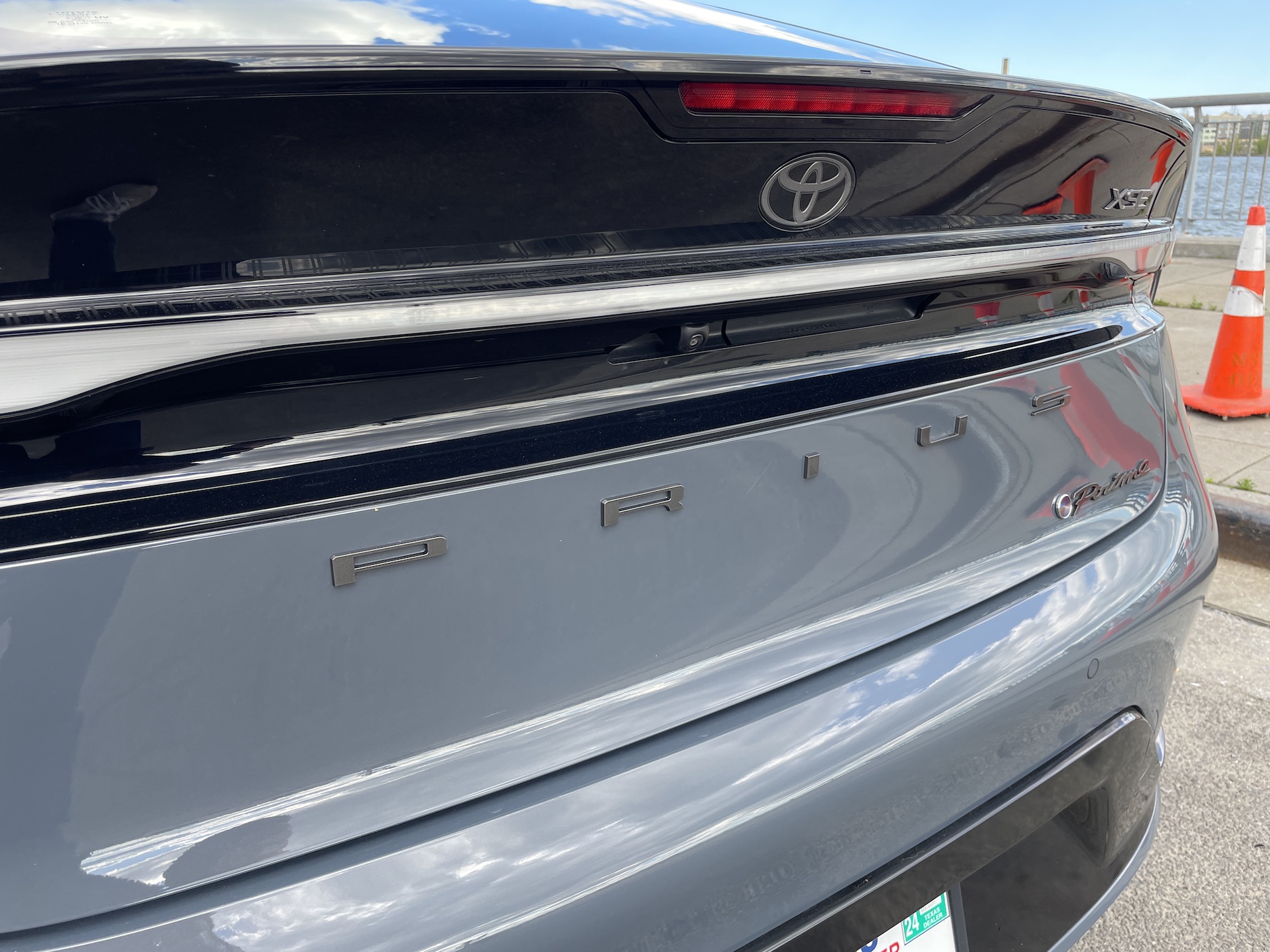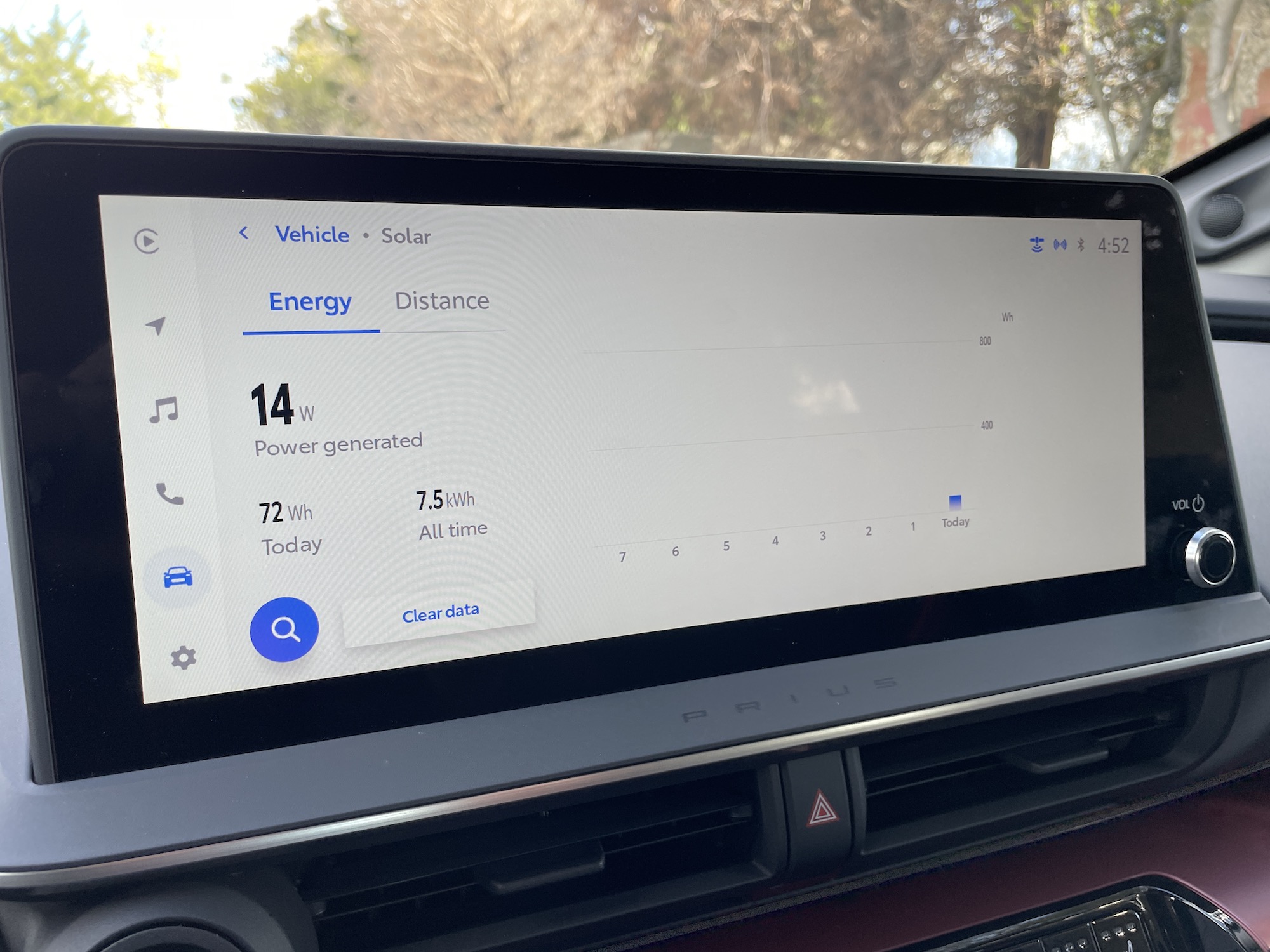My favorite movie in the Rocky franchise is the fourth one. You know, the one where he fights the Soviet superman who killed his friend. Even after all of these decades—including some legitimately good and not-’80s-cheeseball entries like Michael B. Jordan’s Creed films—Rocky training in the wilderness so he can personally defeat communism is still a consistent Friday night go-to move at my house.
There’s a scene in the climactic bout when Russian boxer Ivan Drago—depicted, until then, as an almost inhumanly unbeatable fighter—takes a bad cut to the eye from Rocky. That’s when starts to realize that for all his pounding and hulking size, he’s not really getting anywhere against Rocky; “He is like a piece of iron,” Drago says as they both go into the ring for another round. And that’s the crucial moment in the film: the one where Drago finally realizes he may just be in over his head.

That is what it’s like to try and use any gasoline in the 2023 Toyota Prius Prime. Long respected by hypermilers, commuters and the Save The Earth crowd for its miserly fuel economy, the unexpectedly sleek and sexy new Prius is an absolute champion at saving gas—and you could make a case that it’s the best car in the Toyota lineup right now.
The Basics
Rebooted late last year, to the surprise of all involved, with aggressive new styling and revised driving dynamics, the fifth-generation Prius has transformed from an object of enthusiast scorn to a machine that demands respect. Earlier this summer, I spent a week in a Prius Prime XSE: the middle trim level of the plug-in hybrid version (the non-Prime Prii are standard hybrids that do not have plugs.)

Price: XSE Premium Starting MSRP: $39,170; as-tested, $41,875*
Horsepower: 220 combined system
Engine: 2.0-liter four-cylinder
Battery: 13.6 kWh
EPA Range: 50/47/48 (city/highway/combined, Toyota estimate)
Drive: Front-wheel-drive
Curb Weight: 3,516 lbs
Body Style: Compact four-door hatchback
*Pre-production prototype tested. Prices are estimated and via Toyota.
How Does It Look?

Great! It looks great. I don’t have much to add here that hasn’t already been written elsewhere, but the new Prius is objectively a win for Toyota’s design team. It even comes in some fun colors for a change, like Supersonic Red or this almost matte-looking Guardian Gray. Sadly, the new Prius’ best color, Maximum Yellow, isn’t an option for U.S. buyers. What a shame that is.
But it’s not surprising the design is cool, when you think about it; the Prius has always represented a master class in understated aerodynamics in its relentless pursuit of fuel economy. Granted, the new 2023 Prius actually has a slightly worse drag coefficient than its predecessor, but it’s so much less dowdy and robotic-looking that absolutely nobody is going to care. But it’s still almost supercar-grade with a drag coefficient of just 0.27.

The Prius does all of this while keeping its compact dimensions. It’s only about an inch longer and wider than the previous car, and about two inches lower overall, which speaks to the more sporting pretenses Toyota sought to instill this time. I really love the overall shape, the short overhangs, that aggressive front end and the horizontal light bar out back.
These days you could argue the Prius is Toyota’s flagship or even halo car: the standard-bearer for its vaunted hybrid system and more in-house than the BMW-sourced, Austrian-built Supra is. At last, the Prius has the looks to back that positioning up.
How’s The Interior?

Much of the rest of the auto industry is chasing the Tesla playbook with “green” cars these days—lots of touchscreens and a focus on minimalism to simultaneously emphasize tech and cut costs. By contrast, the new Prius feels like Toyota’s designers and engineers were explicitly told to double down on what they’ve always done while modernizing things in the process.

The result is a car that feels reasonably high-tech and built to serve its fuel-sipping mission but doesn’t fall victim to too many current trends. I can sum this up with one word: buttons. The 2023 Prius has a good amount of them, and they are welcome here. The steering wheel and climate controls all offer fantastic and intuitive physical controls, with a pleasing design to go with them. Everything here feels pretty high-quality, too. It’s not a Lexus, per se, but it’s one of the nicer Toyotas you can buy.

But it’s not completely old-school. You could never say that about my tester’s 12.3-inch touchscreen, which is huge by modern standards but thankfully positioned in a more landscape position (the vertically oriented big portrait screens do less for me.)

I’d say Toyota’s infotainment and software game is getting better these days—something I definitely couldn’t say in the 2010s—but I still used Apple CarPlay the vast majority of the time here. Thankfully, it and Android Auto are available via a wireless connection, which you still cannot say of things like Hyundai’s current electric vehicles.

Also, major points to Toyota for finally moving the main display unit above the steering wheel, in front of the driver, and not shoving it into a bar-thing at the top-center of the dashboard. It’s easier to read and a very clear, intuitive display in its own right.
What’s It Like To Drive?
As good as it looks, here’s where the Prius most deserves its Hybrid Rocky status—small but unbeatable, capable of sustaining a franchise for decades, and a winner despite always being the underdog somehow.

We’ll start with some context. We—and by that I mean both enthusiasts and normal commuters—do not expect a great driving experience from the Prius. When I moved to Washington D.C. some years ago and didn’t have a car at first (something we rectified in quick order by getting a Mini Cooper S), I often used the Zipcar car-sharing service. If I was lucky, I’d be able to snag an Audi A3 hatchback, which is basically a Volkswagen GTI in a blazer. But most of the time, I got stuck in a third-generation Prius.
As a Prius should be, it was phenomenal at saving gas; that’s the entire point. It was also a slow, unresponsive, almost narcoleptic machine, allergic to any demand for acceleration—which I occasionally did need even in D.C.’s abysmal city and highway traffic. It was a pure commuter car, a means to an end; it had 50 mpg combined and that was the point.
It’s a very different story for the new Prius Prime, which has clearly spent some time chopping wood and running up mountains since its last go-round. In Prime form, this compact plug-in hybrid packs 220 combined system horsepower, nearly 100 up from its predecessor and 26 hp from the standard non-plug Prius.

That output comes from a 2.0-liter Atkinson-cycle four-cylinder engine good for 150 horsepower, and the rest comes from the electrical setup powered by a 13.6-kWh battery. That’s a dual-motor system, one for the drive wheels, one for the planetary gearbox. The result: Car and Driver’s instrumented tests yielded a zero to 60 mph time of 6.7 seconds, which is quite respectable—and a marked improvement over the old days.
Now, despite having almost as much total horsepower as my old Subaru WRX, the Prius Prime is not fast. In the “hybrid vs. EV” debate, acceleration falls pretty firmly in the latter camp. But the Prius Prime does feel quick, more so than I expected. My week of testing involved mostly Brooklyn city driving and errand-running, including a trip to Rockaway Beach. In both settings I was surprised at how punchy the Prius Prime is—it’s great at delivering that no-nonsense electric torque that makes passing a breeze. In short bursts, this thing can move better than you’d think. (As a downside, that engine sounds quite industrial. But I’ve found few modern four-cylinder motors to be terribly pleasing to the ear at all, and engine sounds period are probably on the way out.)

It’s a decent little handler, too. That compact size, short nose and small steering wheel all work together to craft a hybrid that feels pretty agile. Toyota has said its engineers worked to improve the chassis, weight and center of gravity with this new Prius, and all of it shows. Whereas the old Prius was a car I respected but generally loathed driving, I actually looked forward to my time in this little gray tester.
I looked forward! To driving! A Toyota Prius! What fascinating times we find ourselves in.
But you’re not really driving a Prius for fun, right? You’re driving it to save gas. And that’s where this thing still shines the most. The Prius Prime is rated at a very impressive 50 mpg city and 47 mpg highway; I averaged around 48 mpg for my week of testing. Best of all, the Prius Prime offers up to 44 miles of all-electric range, or 39 miles on my XSE thanks to its bigger tires.

The fuel-saving may have been helped by this tester’s solar panel roof, a $610 option that allows some electric accessories like the air conditioner, and the battery itself, to get some juice from the sun. Motor Trend’s testing and optimistic revealed it could add as much as four miles of daily range to the car, though they debated whether it’s worth the cost or not; I think I’d spring for it.
All told, in a week of normal driving—again, mostly short trips, errands and one medium-length drive to the coast—I just didn’t really use gas in the damn thing. At all. Almost no matter how hard I tried. I plugged it in once at a street Level 2 charger to juice up the battery, but I don’t even think I cracked an eighth of a tank before I handed this car back to the press fleet folks.

Just know that the Prius Prime does not have the rapid-fire charging times that many modern EVs do; Toyota says it’ll get fully juiced in four hours on a Level 2 charger, or 11 hours on a standard wall outlet. Then again, being a hybrid, you could argue fast charging just isn’t needed here.
Does The Prius Still Matter?
I chose Rocky IV as an analog for this car for a reason. If this thing is the car version of the fictional boxing champ, I wondered about its mid-career relevance in a world that’s increasingly fully electric. The Prius smacks of effort in a way that the bZ4x, with its awkward name and questionable build quality, does not. Moreover, the Prius proudly remains a compact car in an SUV and truck world. It’s as if Toyota kept evolving a car central to its company thesis, agnostic of so many modern trends—screen dominance, SUV supremacy, the move to battery power.

So did Toyota make the right call here? When it comes to hybrid technology, I believe so. I too have wondered if Toyota’s previous administration got the future all wrong. But as the year went on and EV adoption turned out not to be a smooth upward curve, the value of hybrids in reducing gas use and emissions has become all the more apparent. It’s why Toyota’s applying the same hybrid systems to its new trucks and SUVs, like the Tacoma and Land Cruiser. That’s impressive to see. I’ve had a record number of pals and family members ask me for hybrid recommendations this year, many of them saying they can’t buy another fully gasoline car again; wildfire smoke blanketing your city will do that. We will need hybrid cars for a long time to come in this race to reduce car emissions.

That doesn’t fix the challenge facing the Prius itself. Sales of the car have been down for years, though I owe that more to its size (and for years, cheaper gas) than anything else. Even Toyota’s sales projections for this one are a fraction of the car’s heights a decade earlier. Frankly, I’m shocked Toyota hasn’t made a modern SUV version of the Prius brand yet, though that role is filled by the RAV4 Hybrid and Prime, Highlander Hybrid, Venza, Corolla Cross Hybrid and others.
Then again, I don’t have to question a car’s relevance to give it high marks. And I am giving those to the 2023 Prius Prime. It’s a fantastic car, easily the best Prius yet. Like other hybrids, it’s a fantastic option for those who, for whatever reason, aren’t ready or able to deal with the ongoing hurdles of full EV adoption yet—or just want a great car that doesn’t use much gas or create a lot of carbon emissions. That it looks and drives so well is merely an added bonus these days. I suspect a lot of 2023 Prius buyers will be repeat customers, but I hope some newcomers give it a look as well.

And it’s still a more affordable option. My Prime XSE tester was a pre-production prototype, but Toyota estimated it at $41,875. Not a bad option if running out and buying a $60,000 electric Hyundai and hunting for charging everywhere doesn’t seem palatable to you.

Three Things To Know About The 2023 Toyota Prius Prime XSE
- You actually won’t hate driving this Prius for a change
- You’ll be shocked how much money you don’t spend on gas
- It’s an EV alternative worth your attention
Does It Fulfill Its Purpose?

As a versatile, fuel-saving, low-emission hybrid, yes it does. And it shows Toyota’s still willing to put a ton of work into arguably its most notable car of the past 25 years.

What’s The Punctum Of The 2023 Toyota Prius Prime XSE?
Don’t count the hybrids out just yet. And the 2023 Prius Prime is still a champ that throws a formidable punch.





Just to note – only the top line hyundai EVs approach $60k and they are a lot more car then the Prius. For the money of a Prius, you can pick up some models of Tesla – especially with state and fed incentives, Chevy bolt is $14k cheaper, KIA Niro, about par, Hyundai Kona cheaper, VW something or other about the same etc etc.
I don’t understand why there is not more focus on PHEVs. It seems to me that a PHEV with a range of some where between 50 and 100 miles would allow most drivers to do most of their local driving on electric, and still allow for a road trip that’s not dependent upon our iffy plug in infrastructure. Am I missing something or does this idea belong with turbo diesel station wagons, practical but not appealing to normal people?
Isn’t the performance in pure electric mode lacking? Seems to me that PHEVs have fairly small electric motors so I would think running them only on electric mode would be slow.
Probably not for these Toyota hybrids. I’m not 100% clear on how they work, but I think the gas engine is basically a battery/generator, and it’s the electric motors that do all the real work getting power to the wheels.
We have a C-max Energi, I can’t tell the difference between electric and gas, neither is neck snapping fast. Can’t speak to Toyota, but the ford I believe uses electric assist all the time, but full electric only when there is sufficient charge.
That’s the thing with PHEVs – you aren’t getting full electric power. The humble chevy Bolt is some 200hp and 280ft/lbs of torque. That torque is right away. So, the hybrid experience is different than the full EV experience.
We need to see a good comparo of a half-dozen hybrid vehicles. THAT would be relevant in 2023, and worth reading.
A dissenting voice: generally I do not care one way or another what a car looks like. A checker cab or 1970s Volvo with updated aerodynamics would be just fine. But this one looks like a toy. I also have to wonder if someone over 6 feet tall could fit comfortably and ingress/egress without whacking the head. Of course there is no accounting for taste in cars or otherwise, and I fully appreciate the performance and environmental benefits of this updated Prius.
In California there are still some nuisances to going BEV. Our neighbors got a good deal on a new Bolt. They are trying to get a charger installed at their home. Issues so far: 1) new electrical code forces a new upgraded primary electrical panel (old one too close to gas meter, 2) wiring from main connection to electrical panel must be replaced (new code, again), 3) Pacific Gas & Electric lost the first application and has reset the clock, 4) PG&E says they may need to replace utility pole and there is no schedule for the work. They won’t give up, but it would stop me from going BEV should I need another auto, which may be never (I’m old and have low mileage 2001 Toyota Highlander and 2004 Acura TL).
Depending on how much you drive, an L1 charger can be enough for a BEV (or PHEV). It’ll still pick up 40-60 miles of range overnight, with nothing needed but a standard 15A socket.
PG&E drags their feet and has a system intentionally set up to cause delays and unnecessary frustration. When you call with a question, the person who answers never has access to that information. Emailed inquiries are answered a week or more later, or never at all.
Their public relations commercials are a bunch of hooie. Solar power and electric vehicle chargers are not good for their highly profitable business model.
So to stick it to the man, be persistent and patient, and keep on keeping on.
My 2017 Volt does the same things almost as well, and it was $14500 off lease with 20k miles and a hell of a lot of warranty left. The Prius is gorgeous, and a worthy successor, but I always feel like the Volt was there all along, and then Toyota does it oh NOW it’s a big deal. Bizarre.
It always felt that even GM didn’t want to spend the effort on the Volt.
All those I knew that owned one, wished GM came out with a refreshed one when it came time to replace it.
With Toyota, it’s more likely that it’ll be more than a flash in the pan.
Yeah I don’t know what I’m going to do when this one expires. I had a Gen1 now a Gen2. I hope there are more options out there. Maybe by the time I need one a RAV4 Prime won’t be totally unobtainable.
I’m driving a 2017 Prius Prime and have loved the 63 mpg. Any data on the longevity I can expect from the hybrid battery, repair or replacement costs? Am considering selling it to my sons family and investing in the 2023 reviewed here… especially if I can get a tax credit?